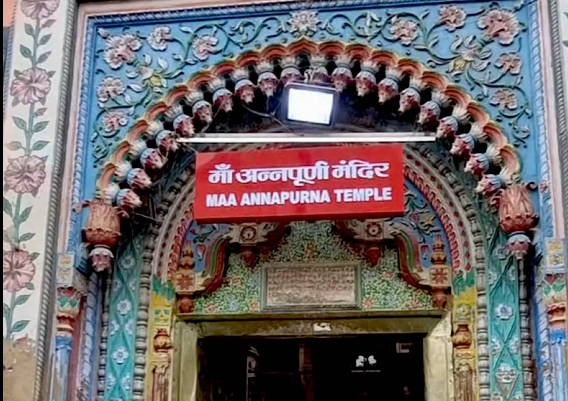Shree Annapurna Devi Temple Varanasi Experience Varanasi
🖼️ Photo Gallery




🛕 Temple Info
Stepping out of the vibrant chaos of Varanasi's lanes and into the sanctum of the Shree Annapurna Devi Temple is like entering a different realm. Located a mere 15 meters from the iconic Kashi Vishwanath Temple, in the labyrinthine Vishwanath Galli, this temple is a serene oasis of profound spiritual energy. The atmosphere is not one of frantic devotion, but of a deep, calming peace, filled with the gentle hum of prayers and the fragrant scent of flowers and incense.
The temple, built in the classic Nagara architectural style, features a grand, pillared porch that leads to the inner sanctum. While the structure is elegant, the true focus is the divine presence within. The main idol of Goddess Annapurna is breathtakingly beautiful and radiates a motherly grace. She is depicted holding a golden vessel of cooked rice and a ladle, symbolizing her eternal role as the nourisher of the world. The temple complex is a microcosm of devotion, housing several smaller shrines dedicated to deities like Lord Ganesha, Kalika Devi, Lakshmi Devi, Surya Bhagwan, and Narsimha, making a visit here a complete spiritual circuit.
A unique and heartwarming aspect of the temple is the continuous Annadanam (free food service) run by the Kashi Annapurna Annakshetra Trust. The sight of devotees and visitors partaking in a simple, satvik meal in the temple's hall is a living testament to the Goddess's promise that no one in her city of Kashi shall ever sleep hungry. The food, often South Indian in style like idli, vada, rice, sambar, and curd, is served with love and is considered a sacred blessing.
💫 Importance
In the spiritual ecosystem of Varanasi, if Lord Vishwanath is the King, Goddess Annapurna is the Queen. She is revered as the divine mother who provides sustenance and nourishment, not just for the body, but for the soul. The name 'Annapurna' itself means "full of food" or "the complete provider of nourishment."
Devotees believe that praying at this temple ensures prosperity, removes all forms of lack, and fulfills one's righteous desires. The temple embodies the core Hindu principle that food is divine and not an illusion. A powerful legend states that once, Lord Shiva declared everything in the world, including food, to be Maya (illusion). Goddess Parvati, as the embodiment of food, disappeared to show him its vital importance, plunging the world into a famine. Shiva, realizing his error, came to her as a beggar in Kashi, and she personally fed him, thus establishing herself as Annapurna, the sustainer of all life.
To this day, the temple distributes a few grains of raw rice to devotees as prasad. This rice is meant to be mixed with one's home grain storage, a symbolic act inviting the Goddess's boundless abundance into one's household.
📜 History
The current temple structure has a rich historical lineage, constructed in 1729 AD by the Maratha Peshwa Baji Rao I, a great patron of Hindu culture and temples. However, the spiritual significance of the site is timeless, rooted in the Kashi Khanda and other sacred texts.
The temple houses two principal idols of the Goddess. The one made of brass is available for daily darshan, allowing devotees to receive her blessings every day. The second idol, a magnificent golden statue, is revealed to the public only once a year on the day of Annakut, which falls on the fourth day of Diwali. This annual event draws thousands of devotees who vie for a glimpse of the resplendent golden deity and receive the special prasad of coins and rice, believed to bring immense prosperity.
Another legend associated with the temple involves the sage Vyasa. When he and his disciples faced a food shortage in Kashi, he grew angry. It was then that Goddess Annapurna, disguised as an old woman, provided a grand feast for them, humbling the sage and demonstrating that in Kashi, the Mother's compassion knows no bounds.
🪔 Pooja Timings
- Temple Opening Hours: 4:00 AM to 11:30 PM (with a break typically between 1:30 PM to 4:00 PM, though timings can vary).
- Mangala Aarti: The day begins with the soul-stirring Mangala Aarti at 4:00 AM, a serene experience that awakens the deity.
- Other Aartis: Aartis are also performed at 12:00 PM and 8:30 PM, with the Shayan Aarti (night ritual) around 10:00 PM.
- Annadanam (Free Food Service): The free meals are served throughout the day, typically from early morning (around 7:00 AM) until late night (around 10:00 PM), with specific timings for breakfast, lunch, and dinner.
🚌 Transport Options
- By Air: The nearest airport is Lal Bahadur Shastri International Airport in Varanasi (Babatpur), located approximately 25-30 km from the temple. From the airport, one can hire a taxi or an auto-rickshaw to reach the Vishwanath Gali area.
- By Rail: Varanasi Junction (BSB) is the main railway station, situated about 5 km southeast of the temple. It is one of the busiest stations in India, with trains connecting to all major cities. From the station, taxis, auto-rickshaws, and cycle-rickshaws are readily available.
- By Road: Varanasi has excellent road connectivity to cities across Uttar Pradesh and neighboring states. The temple is located in the heart of the old city, near Dashashwamedh Ghat. Once in the vicinity, the narrow lanes leading to the temple are accessible only on foot.
🏙️ Nearby Cities
- Prayagraj: ~125 km
- Ayodhya: ~200 km
- Gorakhpur: ~230 km
- Lucknow: ~285 km
MytempleMypride Reflection
A visit to the Annapurna Devi Temple is a humbling encounter with the Divine Mother in her most compassionate form. It is a powerful reminder that true devotion is expressed not only in prayer but also in the selfless act of feeding the hungry. This sacred abode fills the heart with gratitude and reinforces the timeless truth that in the kingdom of Kashi, the grace of the Mother ensures that no soul is ever left wanting.